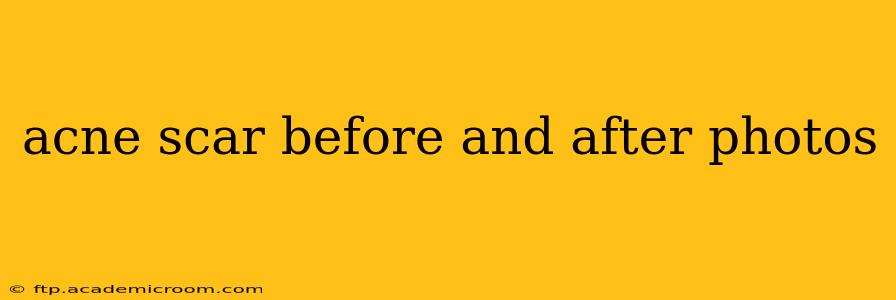Acne scars can be a significant source of frustration and self-consciousness. Seeing compelling before-and-after photos of acne scar treatments is often the first step in someone's journey to clearer skin. This guide explores the different types of acne scars, common treatment options, and what realistic expectations should be when considering treatment. We'll also address some frequently asked questions surrounding acne scar improvement.
What are the Different Types of Acne Scars?
Understanding the type of acne scar you have is crucial in determining the most effective treatment. There are several classifications:
- Ice Pick Scars: These are deep, narrow, pitted scars that resemble small holes in the skin. They are notoriously difficult to treat.
- Boxcar Scars: These are broad, U-shaped scars with sharply defined edges.
- Rolling Scars: These are characterized by a wave-like, uneven texture to the skin. They often involve wider areas of depressed skin.
- Hypertrophic Scars: These are raised, red scars that extend beyond the original acne lesion. They are a result of excessive collagen production.
- Keloid Scars: Similar to hypertrophic scars, keloids are raised and extend beyond the original wound but grow even larger and can spread beyond the initial scar area.
What Treatment Options Exist for Acne Scars?
Numerous treatment options exist, each with varying degrees of effectiveness depending on the scar type and individual skin characteristics. The best approach often involves a combination of therapies:
- Topical Treatments: Retinoids, chemical peels (like glycolic acid or salicylic acid), and topical vitamin C can improve skin texture and reduce the appearance of less severe scars.
- Microneedling: This minimally invasive procedure uses tiny needles to create micro-injuries in the skin, stimulating collagen production and improving skin texture. It is often effective for rolling and boxcar scars.
- Laser Resurfacing: Different types of lasers can target acne scars, improving texture and reducing the appearance of discoloration. Ablative lasers remove the top layer of skin, while non-ablative lasers stimulate collagen production without removing skin. This can be particularly effective for various scar types.
- Dermal Fillers: These are injectables that add volume to depressed scars, making them less noticeable. They are often used for ice pick and boxcar scars.
- Subcision: This procedure involves releasing scar tissue from underneath the skin, lifting depressed areas and improving the appearance of rolling and boxcar scars.
- Surgery: In severe cases, surgical excision or skin grafting may be necessary to remove or replace severely scarred tissue.
Can I See Before and After Photos of Acne Scar Treatments?
While I cannot display images directly, searching online for "[specific treatment] acne scar before and after" (e.g., "microneedling acne scar before and after") will yield numerous results. Remember to be critical of the images you find and consider the source's credibility. Look for before-and-after photos on reputable dermatology websites or those from board-certified dermatologists.
How Long Does It Take to See Results from Acne Scar Treatment?
The timeline for seeing results varies significantly depending on the treatment method, severity of scarring, and individual healing response. Some treatments, like topical creams, may take several months to show noticeable improvements, while others, such as laser resurfacing, may show more immediate results but require multiple sessions. It’s important to have realistic expectations and a long-term perspective.
Are Acne Scar Treatments Painful?
The level of discomfort varies depending on the specific treatment. Some treatments, such as topical creams, are virtually painless, while others, like laser resurfacing or subcision, may require local anesthesia and cause some discomfort during and after the procedure. Your dermatologist will discuss pain management options with you.
What is the Cost of Acne Scar Treatment?
The cost of acne scar treatments can vary widely depending on the type of treatment, the number of sessions required, and the geographical location. It's best to consult with a dermatologist for a personalized cost estimate.
What are the Risks and Side Effects of Acne Scar Treatment?
Like any medical procedure, acne scar treatments carry potential risks and side effects. These can include redness, swelling, bruising, infection, and hyperpigmentation (darkening of the skin). Your dermatologist will discuss these risks with you in detail before you undergo any procedure. Always choose a qualified and experienced professional to minimize potential complications.
This information is for educational purposes only and should not be considered medical advice. Always consult with a board-certified dermatologist to discuss your specific acne scar concerns and to determine the best treatment plan for your individual needs. They can provide personalized recommendations and realistic expectations based on your skin type and the severity of your scarring.
